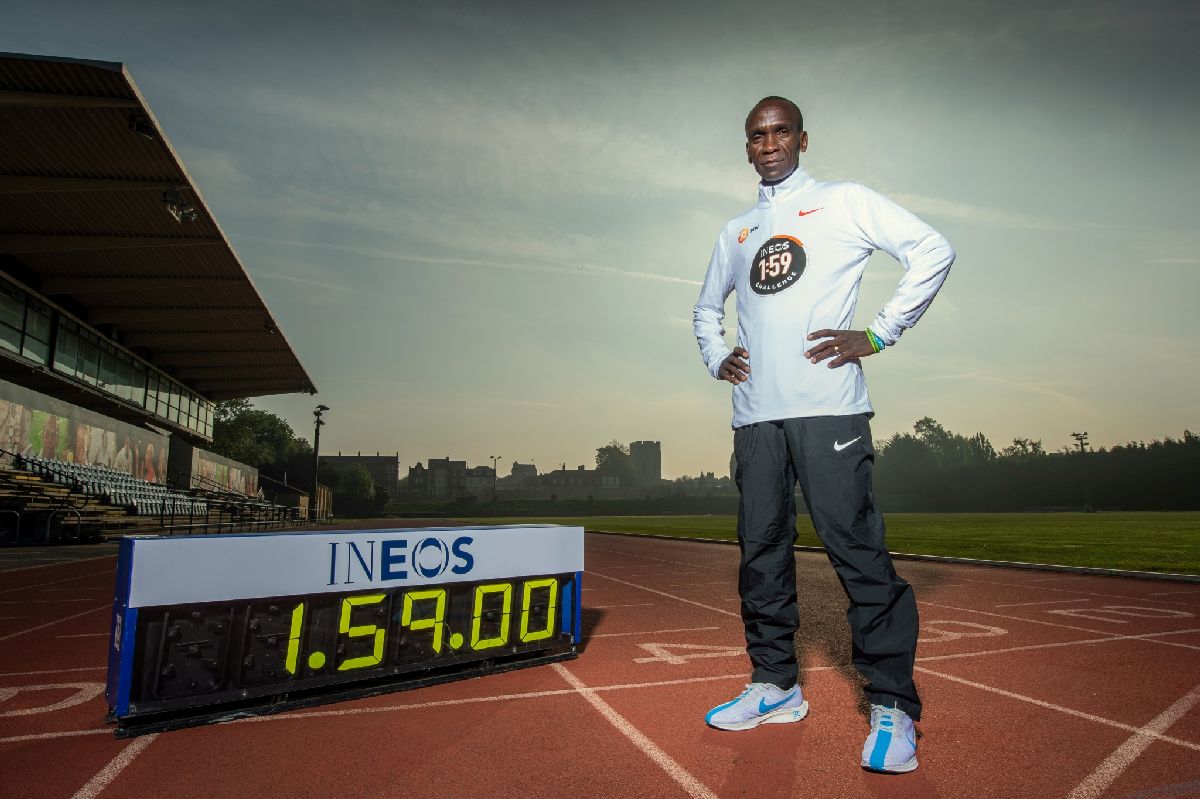Eliud Kipchoge has been the best marathon runner in the world for years.
The former world record holder had made it in 2019 in Vienna on the Prater Hauptallee at the INEOS 1:59 Challenge as the first person to run the marathon under two hours.
Speaking to the portal sweatelite, his training colleague Patrick Sang gave insights into Eliud Kipchoge's marathon training.
This is the typical training week of Eliud Kipchoge
This is how Eliud Kipchoge trains:
MONDAY
Morning: Easy to moderate run (16 - 21 km)
Afternoon: Easy run (8 - 12 km)
TUESDAY
Tuesday is track day. On this day, Kipchoge completes a unit on the track. He alternates between the following blocks in a 2-week rhythm:
Interval training with 15 kilometers at marathon pace (2:50 - 2:55 min/km).
15 x 1,000 meters in 2:50 - 2:55 with 90 seconds rest. The first intervals are run slower (3:00) and then increased to 2:50 minutes.
12 x 1.200 meters in 3:24 - 3:30 with 90 seconds rest
5 x 2 km + 1 km in 5:40 - 5:50 and 2:50 - 2:55.
Interval training with 10 - 15 kilometers faster than the marathon pace
12 x 800 meters in 2:10 (= 2:43 min/km) + 10 x 400 in 1:02 (=2:35 min/km) with 90 seconds rest each time
1,200 meters in 3:25, 400 meters jogging, 5 x 1,000 meters in 2:55 (90 seconds break), 400 meters jogging (series break), 3 x 300 meters in 42 - 40 seconds (60 seconds break), 400 meters jogging (series break), 2 x 200 meters in 27 seconds (60 seconds break)
20 x 400 meters in 64 - 65 seconds (50 seconds rest)
WEDNESDAY
Morning: Easy to moderate run (16 - 21 km)
Afternoon: Easy run (8 - 12 km)
THURSDAY
Long tempo run between 30 and 40 kilometers and sometimes, depending on physical condition, a second run in the afternoon.
The group usually starts from Kaptagat shortly after six in the morning. The first one or two kilometers are used quite casually for the run-in. The first kilometer is run in about 5:00 minutes. From kilometer 3 the planned pace is run: 3:00 - 3:25 minutes per kilometer. The pace depends on the route, which is profiled and mostly on hilly trails. Only a small part of the route is on a flat road, where the pace is increased to 3:00 min/km. On the hilly trail the pace is around 3:15 - 3:25 min/km.
The average pace is usually between 3:15 and 3:20 min/km - 20 to 25 seconds above the marathon pace. Usually a run of around 30 kilometers is completed in one week and a 40-kilometer run the following week.
FRIDAY
Morning: Easy to moderate run (16 - 21 km)
Afternoon: Easy run (8 - 12 km)
SATURDAY
On Saturday, Kipchoge will do a fartlek workout in the morning and possibly an easy run (10 - 12 km) in the afternoon if he still feels fresh.
The fartlek workout (similar to ride play) is also completed on trails and on the road. This involves alternating between other sessions each week:
- 4 to 5 times: 10 minutes fast + 2 minutes easy.
- 6 times: 8 minutes fast + 2 minutes easy
- 8 times: 6 minutes fast + 2 minutes easy
- 10 times: 4 minutes fast + 2 minutes easy
- 13 to 15 times: 3 minutes fast + 1 minute easy
- 17 to 20 times: 2 minutes fast + 1 minute easy
- 25 to 30 times: 1 minute fast + 1 minute easy
The units marked in bold are the ones with higher priority and are completed twice as often as the other units. It is very difficult to give an indication of speed because running is done on hilly terrain and the pace varies accordingly. On flat sections, the pace is about 2:55 min/km for the 10-minute repeats or 2:45 min/km for the 1-minute repeats. That means the pace is, if then only minimally faster than marathon pace. The warm-up and cool-down are surprisingly very short (10 - 15 minutes). A typical warm-up is two kilometers of jogging in 10 minutes (about 5:00 min/km) and 2 minutes of dynamic stretching.
SUNDAY
Morning: Easy to moderate run (18 - 22 km)
Conclusion
So, surprisingly, Kipchoge's training is not very complex. Monday, Wednesday, Friday and Sunday are quiet days with easy endurance runs. Tuesday is track day, Thursday is the long endurance run (at a brisk pace) and Saturday is followed by a road race.
Note: Eliud Kipchoge does the training at over 2,000 meters in the highlands. This makes running a touch more challenging. Kipchoge also places a high priority on strength training.
The excerpt is from the training for the 2017 Berlin Marathon. However, not much has changed in the training program to date, so Kipchoge also completes a similar weekly workload for the INEOS 1:59 Challenge in Vienna. At the INEOS 1:59 Challenge, he was the first person to run the marathon in non-record conditions.
More Marathon:


![Running events in September 2026 [Running Calendar] Running calendar: Running competitions in September](/images/thumbnails/raxo/tb-w364-h121-cut-int-2900c917ef7e6c1f41648a9d77e0fff1.webp)

Kommentar schreiben